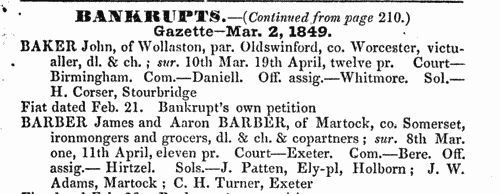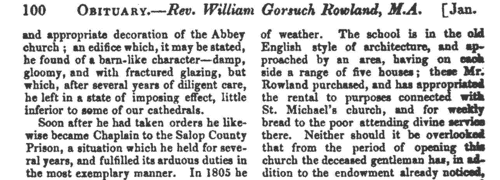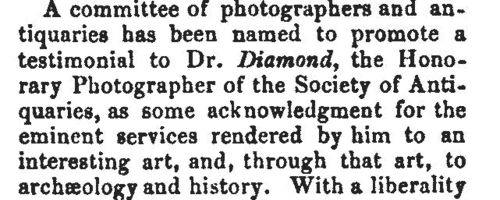Oxford Surname Ancestry ResultsOur indexes 1845-1865 include entries for the spelling 'oxford'. In the period you have requested, we have the following 24 records (displaying 1 to 10): Single Surname Subscription | | | Buying all 24 results of this search individually would cost £132.00. But you can have free access to all 24 records for a year, to view, to save and print, for £100. Save £32.00. More... |
These sample scans are from the original record. You will get scans of the full pages or articles where the surname you searched for has been found. Your web browser may prevent the sample windows from opening; in this case please change your browser settings to allow pop-up windows from this site. Bankrupts in England and Wales
(1849)
Perry's Bankrupt and Insolvent Gazette, issued monthly, included lists of bankruptcies and stages in the liquidation of the estate, payment of dividends, and discharge. The initial entry in this sequence gives the name of the bankrupt (surname first, in capitals), the date gazetted, address and trade (often with the phrase dlr. and ch., meaning dealer and chapman); the dates and times and courts of the official processes of surrender; the surname of the official commissioner (Com.); the surname of the official assignee; and the names and addresses of the solicitors; the date of the fiat; and whether on the bankrupt's own petition, or at the demand of petitioning creditors, whose names, trades and addresses are given. In subsequent entries the bankrupt is often merely referred to by name and trade. This is the index to the names of the bankrupts, from the issues from January to December 1849, which may or may not include the detailed first entry for any particular individual.OXFORD. Cost: £6.00.  | Sample scan, click to enlarge

| Inhabitants of Birmingham
(1850)
Francis White & Co.'s History, Gazetteer, and Directory of Warwickshire for 1850 lists nobility, gentry, clergy, other private residents, farmers and traders, hundred by hundred and village by village, with separate sections for the large towns. This long alphabetical section lists inhabitants of Birmingham.OXFORD. Cost: £4.00.  | Sample scan, click to enlarge

|  Criminal lunatics in Surrey
(1851) Criminal lunatics in Surrey
(1851)
The 1851 census return for the Royal Hospital of Bethlehem or Bethlem, founded by Edward VI for the cure of poor lunatics. The hospital lay in the parish of St George the Martyr, Southwark, in St Jude ecclesiastical district. The return of patients was divided into three sections: curable, incurable and criminal lunatics. This index covers the criminal.OXFORD. Cost: £4.00.  | Sample scan, click to enlarge

|  Inhabitants of Southwark in Surrey
(1851) Inhabitants of Southwark in Surrey
(1851)
The 1851 census return for St George the Martyr, Southwark, registration district: London Road sub-district: enumeration district 12: described as: "Webber St (north side) No 19 (Pidmores) to No 1a next the Assembly Rooms - Valentine Row No 1 (Percivals) to No 18 - Angel Place, No 1 to No 15 (to railing) - Webber St (south side) from Riding School to Sturrack's inclusive - Webber Row (both sides) No 30 to Waterloo Road including Pape's Court - Cottage Gardens - Spiller's Court - Hedger's Court - Grotto Place & Gardens - and Williams Court." This area lay in the parish of St George the Martyr, Southwark. The addresses listed in the actual returns are 1 to 19 Webber Street, 1 Grey Street, 1 to 18 Valentine Row, 1 to 12 Angel Place, 1 to 6 Webber Street South, 1 to 47 Webber Row (various numbers), 1 to 4 and 48 and 49 Pape's Buildings, 1 to 4 Cottage Gardens, 1 to 8 Spiller's Court, 1 to 8 Hedger's Court, 1 to 6 Grotto Place, 7 Grotto Gardens, and 2 to 8 William's Court.OXFORD. Cost: £4.00.  | Sample scan, click to enlarge

|  Patients at Westminster Hospital
(1851) Patients at Westminster Hospital
(1851)
In the 1851 census, Westminster superintendent registrar's district, St Margaret's registrar's district, enumeration district 8 comprised part of St Margaret's parish and St Margaret's ecclesiastical district in the city of Westminster. HO 107/1480
OXFORD. Cost: £2.00.  | Sample scan, click to enlarge

| Traders and professionals in London
(1851)
The Post Office London Directory for 1851 includes this 'Commercial and Professional Directory', recording about 80,000 individuals. OXFORD. Cost: £4.00.  | Sample scan, click to enlarge

| Deaths, Marriages, News and Promotions
(1852)
Death notices and obituaries, marriage and birth notices, civil and military promotions, clerical preferments and domestic occurrences, as reported in the Gentleman's Magazine. Mostly from England and Wales, but items from Ireland, Scotland and abroad. January to June 1852
OXFORD. Cost: £4.00.  | Sample scan, click to enlarge

| Deaths, Marriages, News and Promotions
(1855)
Death notices and obituaries, marriage and birth notices, civil and military promotions, clerical preferments and domestic occurrences, as reported in the Gentleman's Magazine. Mostly from England and Wales, but items from Ireland, Scotland and abroad. January to June 1855
OXFORD. Cost: £4.00.  | Sample scan, click to enlarge

|  Sailors and marines on H. M. S. Agamemnon in the Crimean War
(1854-1856) Sailors and marines on H. M. S. Agamemnon in the Crimean War
(1854-1856)
Sebastopol in the Crimea was the great Russian naval arsenal on the Black Sea. A combined assault by British, French and Turkish troops resulted in the reduction of Sebastopol and led to the Treaty of Paris of 27 April 1856, guaranteeing the independence of the Ottoman Empire. By Admiralty Order the Crimea Medal was awarded to sailors and marines present during the campaign, between 17 September 1854 (the first landing at Eupatoria) and 9 September 1855 (when the allies secured Sebastopol). The sailors' medals were mostly delivered to them on board ship in the course of 1856; the marines' medals were sent to their respective headquarters for distribution. The remarks as to distribution in this medal roll therefore give more specific information as to the whereabouts of the sailor recipients in 1856 than about the marines. Her Majesty's Ship Agamemnon, a 91-gun screw steamer, took part in the assault. Four clasps to this medal were awarded to the men present in the actions at Sebastopol itself, Inkerman, Balaklave (Balaclava) and (the sea of) Azoff, but the recipients of these clasps are recorded on separate rolls, not part of this index, but indexed on this site.OXFORD. Cost: £8.00.  | Sample scan, click to enlarge

|  Sailors and marines on H. M. S. Princess Royal in the Crimean War
(1854-1856) Sailors and marines on H. M. S. Princess Royal in the Crimean War
(1854-1856)
Sebastopol in the Crimea was the great Russian naval arsenal on the Black Sea. A combined assault by British, French and Turkish troops resulted in the reduction of Sebastopol and led to the Treaty of Paris of 27 April 1856, guaranteeing the independence of the Ottoman Empire. By Admiralty Order the Crimea Medal was awarded to sailors and marines present during the campaign, between 17 September 1854 (the first landing at Eupatoria) and 9 September 1855 (when the allies secured Sebastopol). The sailors' medals were mostly delivered to them on board ship in the course of 1856; the marines' medals were sent to their respective headquarters for distribution. The remarks as to distribution in this medal roll therefore give more specific information as to the whereabouts of the sailor recipients in 1856 than about the marines. Her Majesty's Ship Princess Royal, a 90-gun screw steamer, took part in the assault. Four clasps to this medal were awarded to the men present in the actions at Sebastopol itself, Inkerman, Balaklave (Balaclava) and (the sea of) Azoff, but the recipients of these clasps are recorded on separate rolls, not part of this index, but indexed on this site.OXFORD. Cost: £8.00.  | Sample scan, click to enlarge

|
Research your ancestry, family history, genealogy and one-name study by direct access to original records and archives indexed by surname.
|













